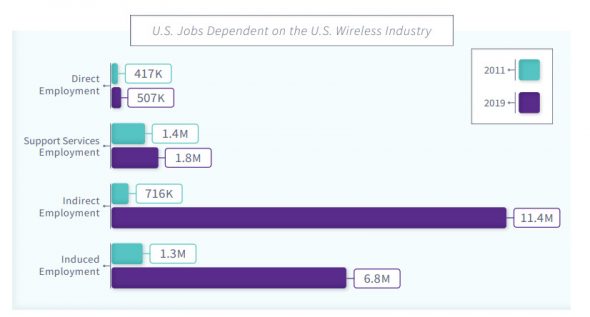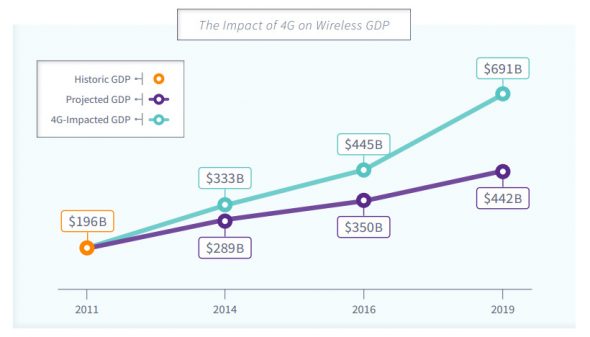 Nearly 17 million new U.S. jobs (16.7 million) were created during the nine-year period when 4G wireless networks were deployed and became a key driver of the U.S. economy, according to a new report from wireless industry association CTIA. At the beginning of the 4G era in 2011, 3.7 million jobs were connected to the wireless industry – a number that rose to 20.4 million by 2019.
Nearly 17 million new U.S. jobs (16.7 million) were created during the nine-year period when 4G wireless networks were deployed and became a key driver of the U.S. economy, according to a new report from wireless industry association CTIA. At the beginning of the 4G era in 2011, 3.7 million jobs were connected to the wireless industry – a number that rose to 20.4 million by 2019.
The wireless job creation estimates were made by Recon Analytics and are included in a report titled “The 4G Decade: Quantifying the Benefits.” Overall, the U.S wireless industry gross domestic product (GDP) grew 253% to $690.5 billion between 2011 and 2019, according to the report.
4G Wireless Job Creation
The CTIA/Recon Analytics 4G wireless job creation estimate includes four types of jobs:
- Direct jobs for wireless industry employers
- Support jobs in the industry such as contractors or programmers creating new wireless apps
- Indirect jobs that rely on the wireless industry such as retailers
- Induced employment resulting when directly and indirectly generated incomes are spent and re-spent in the broader economy on items such as clothing and entertainment
The “indirect” job category saw particularly strong growth as a result of 4G – a phenomenon the researchers attribute to the advent and rise of the “on-demand” economy. As the researchers explain, that’s a “new sector built completely on the sophistication of smartphones and increased capacity, availability and adoption of 4G networks.”

The availability of new spectrum for wireless helped drive the wireless economy, the researchers noted. The report estimates that 524,000 new jobs are created by every 10 MHz of low-band spectrum auctioned to the wireless industry.
4G Wireless Economic Benefits
The impact of 4G wireless was greater than experts predicted, according to the CTIA/Recon Analytics report. The experts expected the industry’s GDP to increase by 126% between 2011 and 2019 to $441.8 billion. But instead, wireless GDP hit $690.5 billion in 2019.

In comparison, the overall U. S. economy grew 38% during the same period.
That means that 10% of the increase in U.S. GDP during the 4G era was due to the wireless industry, the researchers noted.
The new CTIA/Recon Analytics report builds on previous research from the duo about the economic impact of wireless.
Other highlights from the latest CTIA/Recon Analytics report:
- Wireless capital investment for 4G was $261 billion between 2011 and 2019 – a big jump from the $183 billion that was invested in 3G between 2003 and 2010 and an even bigger jump from the $19 billion that was invested in first-generation wireless between 1983-1994.
- In 2019, a single-line wireless subscriber saved $576.60 annually compared to 2010 prices as the average cost of a single-line mobile plan dropped from $113.87 to $64.95.
The 4G wireless job creation and economic impact has created high expectations for nascent 5G networks and services. It will be interesting to see if 5G can maintain or even increase the momentum.


